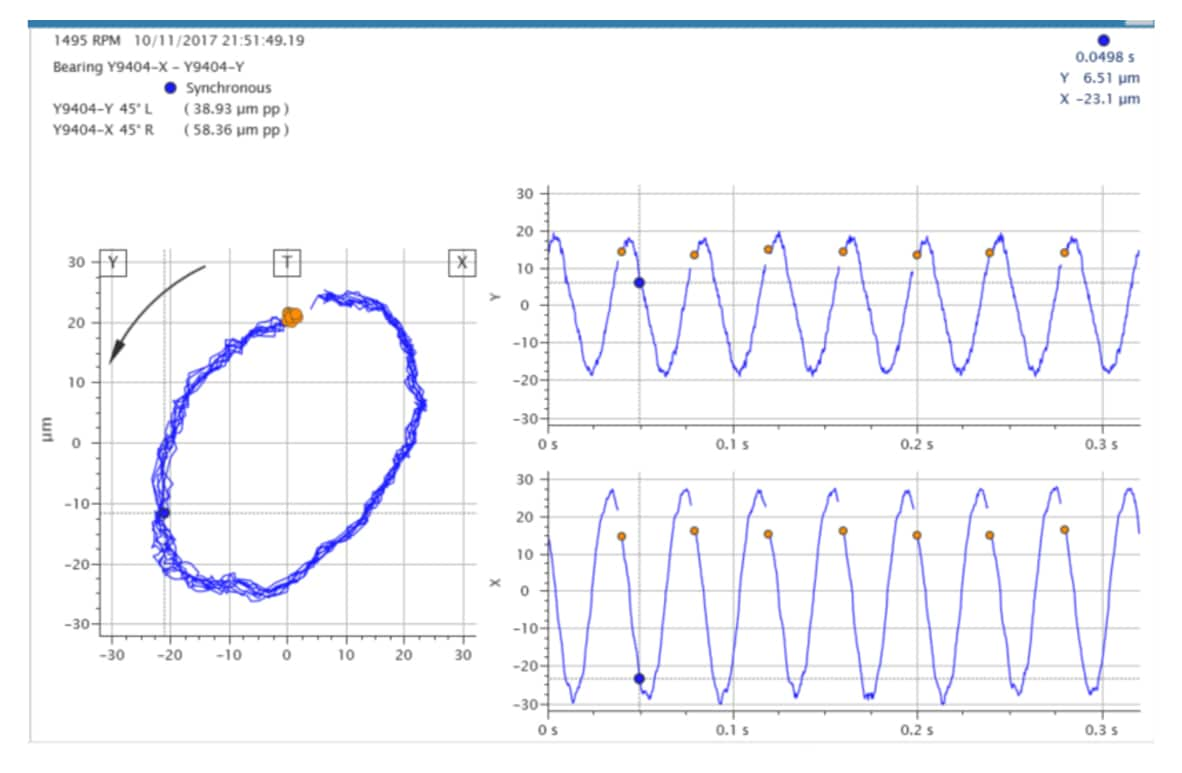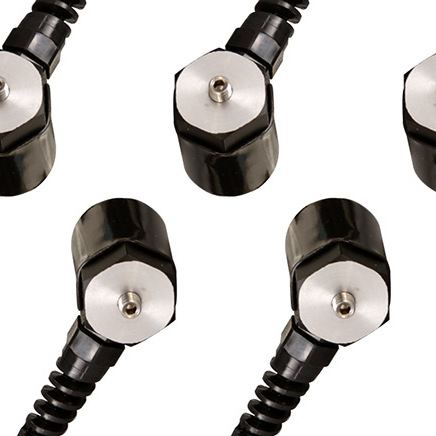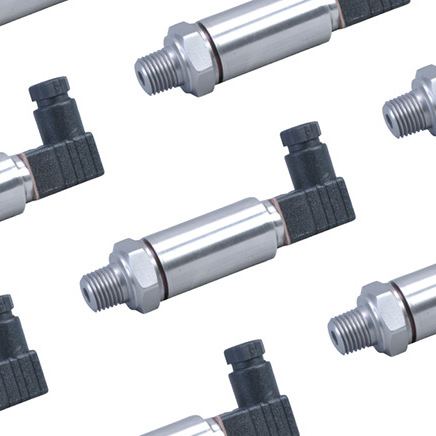What is Vibration?
Vibration in a rotating and/or reciprocating machinery system is, simply put, the back-and-forth movement or oscillation of the machines and components that make up the system. While vibration in industrial equipment is often a normal part of machine operation, it also can be a sign – or the cause – of a problem. If left unchecked, the increasing vibration can cause a progressively deteriorating fault condition, leading to asset component damage – or even a catastrophic failure. Proactive vibration monitoring is the best course of action to prevent catastrophic failures, reduce downtime, and lower maintenance costs. And a vibration sensor is the most effective means for vibration monitoring.
What is a Vibration Sensor?
A vibration sensor is a device that measures the amplitude of vibration within a given piece of equipment over time.

Figure 1. Plot showing the vibration signal over a 0.4 second time period from a gas compressor.
The vibration signal is then processed to provide precise information (frequency vs. amplitude) used to assess the health of the key assets of an industrial system. It connects to a machine or component directly, and, once placed, can detect vibrations through various means – depending on the sensor. The data provided by vibration sensors can help in anticipating future maintenance needs and the result is a more streamlined and efficient operating process, making the assets more reliable and efficient.
Vibration sensors, together with speed/phase reference sensors or other vibration sensors, collect three types of data: frequency, amplitude, and phase. The frequency part of the data indicates how often the vibration occurs (which is related to where the fault is occurring in the machine), while the amplitude part of the data reflects the level of vibration a piece of equipment is experiencing (which is related to the fault severity). Phase indicates where the vibration peak is occurring in relation to a single rotation of the shaft or rotor, which can be used for fault diagnostic purposes and rotor balancing.

Figure 2. Spectrum plot that has been created from the signal shown in Figure 1. Here you can see the individual frequency components together with their amplitude that make up the signal.

Figure 3. Orbit plot on the left is constructed from the signals of two sensors mounted 90 degrees apart for monitoring the shaft vibration, shown on the right. Notice the phase difference between the two sensor signals.
Why is Vibration Monitoring Important for Industrial Systems?
When managing and operating an industrial system, condition monitoring is critical. Proper condition monitoring, which maximizes the operative capacity of equipment while minimizing exposure risk, prolongs the life of assets, which, in turn, leads to less equipment downtime, fewer interruptions to operations, improved efficiency, and, ultimately, reduced asset life-cycle costs. For industrial equipment, vibration is one of the major variables for which proactive condition monitoring is essential.
Root Cause Analysis
Vibration monitoring and analysis can help with root cause analysis; if there is damage to a piece of equipment, tracking down the root source of vibration can lead to an understanding of the cause of that damage and insight into how to avoid re-occurrence.
Predictive Maintenance
While root cause analysis is an important benefit, vibration monitoring is perhaps most valuable when used in predictive maintenance – as a means of preventing the failure from occurring in the first place. Using a vibration sensor, vibration data can be tracked in real time. Early detection of increased vibration within a piece of equipment allows for maintenance actions to be cost-effectively planned ahead of time, preventing damage from occurring or developing.
Who Can Benefit from Vibration Sensors?
Any business that operates rotating and/or reciprocating machinery can benefit from the use of vibration sensors. This includes:
- Oil & Gas
- Renewable Power
- Thermal Power
- Processing Industry
Wherever there are components in motion, vibration exists and can be monitored. A few real-life cases where vibration sensors are necessary include a number of critical machines such as compressors (centrifugal, axial, reciprocating, and screw) and turbines (gas, steam, hydraulic, and wind). Balance-of-plant machines are also monitored, such as:
Fans- Fans are used in a number of applications. The blades can collect deposits that can lead to less efficiency, and can stress the bearings and gearbox to prematurely fail.
Motors- Besides the rotating parts that create centrifugal forces, electric motors also have electromagnetic forces generated due to its operating mode, all of these forces may cause a system to become unstable. In an industrial setting, vibration sensors are used to monitor vibration levels within the motor that can be caused by broken rotor bars, broken end ring, defect bearings, etc.
Pumps- Pumps carry fluids between two different height levels. Like motors, pumps generate centrifugal force due to rotary motion. Vibration sensors allow engineers or technicians to monitor the vibration frequency resulting from the pump operation.
Compressors- A compressor is a mechanical device that increases the pressure of a gas by reducing its volume. Like motors and pumps, compressors generate centrifugal force due to rotary motion. Vibration sensors allow engineers or technicians to monitor the vibration frequency resulting from the compressor elements, bearings, and shafts.
In all applications, measuring and monitoring machine vibration will allow managers and operators to predict failures, find the best operational conditions, and prevent hazards within the workplace.
Primary Types of Vibration Sensors
There are three primary types of vibration sensors, each with their own advantages and disadvantages:
- Accelerometers – Measure absolute vibration acceleration directly
- Velocity Sensors – Measure absolute vibration velocity directly
- Displacement Sensors (Proximity Probes or Eddy Current Probes) - Measure relative vibration in displacement directly (DC – static displacement / AC – variable displacement)
Advantages & Disadvantages of Different Types of Vibration Sensors
Accelerometers
Accelerometers are excellent sensors for rolling element bearing and gear fault detection, or just about any faults that are in the mid- to high-frequency range – including short duration impacts. They are also great for detecting unbalance, misalignment, bent shaft, lose or broken parts, component resonances, etc. Accelerometers are the most common sensor used in vibration monitoring applications. They offer a large frequency range and have a long-life expectancy (>20 years). They are available in small sizes, application-specific designs, and high temperature units.
Velocity Sensors
Velocity sensors are easy to install, and are great for general vibration measurement and monitoring on rotating and reciprocating machinery. They are not sensitive to the surface to which they are mounted, they are used for medium frequency measurements, and they provide a good temperature range. Velocity sensors are electrodynamic, which means they self-generate their signal – so they require no power supply.
Velocity sensors, however, do have their disadvantages. They are more expensive than most accelerometers and they are limited in their life span – as the spring (membrane) where the internal magnet of the sensor is suspended will eventually wear out. They have an upper frequency limit as well as a lower resonance frequency due to resonance of the spring/mass, which limits its frequency range. Velocity sensors are also not suitable for early bearing detection, are sensitive to magnetic fields, they are slightly large in size, and their springs can deform over time.
Displacement Sensors
Displacement sensors, also called a proximity probe or Eddy current probe, are non-contact sensors that measure displacement directly and are used to monitor shaft motion and internal clearances. They are the best option to monitor machines with journal and axial trust bearings, and provide a good signal strength at low frequencies. Displacement sensors are reliable and are excellent for protection and monitoring of turbo machinery – regardless of the speed.
Displacement sensors have their disadvantages as well. They are permanently mounted sensors and expensive to install. Displacement sensors are very sensitive to surface material composition and condition and they require a fixed cable length from Eddy probe to oscillator/demodulator.
Which Vibration Sensor Should be Used?
When selecting a vibration sensor, there are certain variables to take into consideration. Vibration level, frequency range, temperature range, and the bearing type (Rolling Element Bearing or Journal Bearing) are all important. The external environment as well as the presence of electromagnetic fields can potentially interfere with sensor readings, so they need to be accounted for. The size and weight of the sensor itself can also play a role in selection for small applications.
How to Set Up a Vibration Monitoring System
In vibration analysis, evaluating and determining the mounting location of an individual sensor is critical. Incorrect mounting of a vibration sensor can lead to unreliable results, so correct mounting of the sensor is vital to ensure accuracy and consistency. A successful installation of a vibration sensor can be accomplished with an understanding of that sensor’s requirements, capabilities, and limitations.
Sensors should be mounted as close to the source of vibration as possible and to a smooth, unpainted, flat area that is oil and grease free and larger than the base of the sensor itself. To ensure that the sensor detects faults in machine components, it should be mounted in the location with the proper orientation in order to allow for the correct vibration direction to be monitored effectively (horizontal, vertical, and/or axial movement).
Fundamentally, setting up a vibration monitoring system consists of three parts:
Sensor Mounting
- Correctly mounting the sensor onto the system is critical to ensure accurate measurements. Generally, the nearer you place the vibration sensor to the shaft supports (bearings), the better the sensor will measure vibrations – particularly the high-frequency signals.
- You can use several mounting methods for accelerometers and velocity sensors – such as studs, adhesive mounts, flat or 2-poled magnets, or probe tips. The mounting method will affect the frequency range the sensor is able to measure (accelerometers), which is particularly important with high frequencies. Displacement sensors are generally screwed into place through the casing to monitor the relative vibration of the shaft, with the proper gap distance for that sensor. Displacement sensors used for vibration and speed/phrase reference monitoring require rigid mounting when attaching the sensor to the machine.
Wiring
- Good wiring or cabling is also integral to an efficient vibration measurement system. When it comes to cabling, cable length, and capacitance, routing, grounding, and anchoring are the most critical. There is a maximum length for accelerometers before the signal content starts to diminish. The capacitance of a cable increases with length; therefore, the sensor’s final output will combine its own capacitance with the cable capacitance. Therefore, displacement sensors all have fixed length cables. Routing is the process of determining the path of the cable from the sensor to the acquisition system. Proper routing is necessary because when the cable is routed close to other electronic devices, electromagnetic interference and electro-static discharge from these devices may interfere with the readings from the sensor. Instrumentation cable should be routed in designated instrumentation cable trays and should never be parallel to power cables. It is also important to avoid cable ground looping. Besides these points, cabling or routing should start with properly shielded cables.
Monitoring System Set Up
- Choosing a monitoring system is straight forward as it depends on the sensor being used and its cable. Setting up monitoring system is all about ensuring repeatability and ensuring uninterrupted connection. A monitoring system has two interfaces. The first interface is between the sensor and the data acquisition and processing unit. The second interface sits between the data acquisition and processing system and a network where there are other system and users. Usually, the manufacturer will provide a detailed guide on how to configure the monitoring system properly.

